Canada is implementing significant changes to its work permit regulations beginning in November 2024. These updates aim to adjust the influx of temporary foreign workers, international students, and other non-permanent residents.
The Immigration Levels Plan for 2025–2027, which will be announced on November 1, 2024, outlines key adjustments intended to manage population growth and focus on long-term labor market needs. Here’s a detailed look at what to expect.
Language Proficiency Requirement for Work Permits
One of the major changes involves a language proficiency requirement for certain work permits, specifically for the Post-Graduation Work Permit (PGWP) program:
- Post-Graduation Work Permit (PGWP) applicants will now need to demonstrate proficiency in either English or French.
- The Canadian Language Benchmark (CLB) levels have been set as follows:
- CLB 7 for university graduates
- CLB 5 for college graduates
- This requirement aims to ensure that international graduates have a functional language proficiency, enhancing their ability to integrate into the Canadian job market.
Reduction in Temporary Residents
Canada’s new plan also proposes a reduction in temporary residents from 6.5% to 5% of the population by 2027.
This reduction reflects a targeted approach toward stabilizing the population growth while focusing on bringing in more permanent residents who contribute to long-term economic stability. The 2025–2027 Immigration Levels Plan will detail specific measures to achieve this reduction.
Changes to Post-Graduation Work Permits (PGWP)
The Canadian government is also adjusting PGWP eligibility and duration based on the relevance of graduates’ fields of study to high-demand occupations:
- Shortened Eligibility: Graduates with degrees unrelated to long-term shortage occupations will now only qualify for a two-year PGWP instead of the usual three years.
- Three-Year Permits for Key Fields: Graduates from public colleges in fields linked to long-term shortage occupations, such as healthcare, technology, and skilled trades, will still be eligible for a three-year PGWP.
- These adjustments aim to align the PGWP program with labor market demands and reduce the issuance of 175,000 work permits over the next three years.
Updates to the Spousal Open Work Permit
The Spousal Open Work Permit (SOWP) program will now be limited to spouses of workers in certain high-demand professions. The changes aim to reduce the number of permits issued to spouses and partners, with an expected impact of around 100,000 fewer permits in the coming years.
- Eligibility Limited to High-Demand Occupations: Spouses of highly skilled professionals, including executives, engineers, researchers, attorneys, and technicians, will be eligible for work permits.
- Spouses of Students in Advanced Programs: Eligibility will also be limited to spouses of students enrolled in doctoral, master’s, and certain professional programs.
- Exceptions: Spouses working in construction and healthcare will continue to qualify due to labor shortages in these industries.
Insights from the 2025–2027 Immigration Levels Plan
The Immigration Levels Plan for 2025–2027 will further detail Canada’s strategy for managing immigration and balancing temporary and permanent residency. Marc Miller, Minister of Immigration, Refugees, and Citizenship, will present the plan on November 1, 2024. The plan aims to:
- Address population stabilization while focusing on permanent residency for skilled workers.
- Balance temporary and permanent residents to maintain labor market stability.
- Optimize immigration to ensure long-term contributions to Canada’s economy.
The changes to Canada’s work permit rules in November 2024 reflect a strategic approach to immigration, focusing on language proficiency, relevant fields of study, and labor market needs.
These updates aim to make immigration more sustainable while supporting sectors with high labor demands. For those impacted, understanding the new eligibility requirements and planning accordingly will be essential.



















